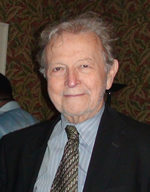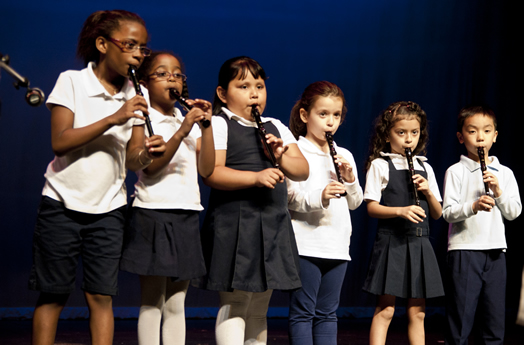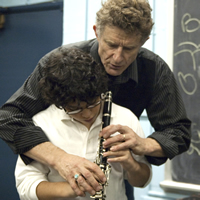Allegro
It’s Better in the Bronx
Volume 114, No. 4April, 2014

Bill Scribner
When bassoonist Bill Scribner arrived in New York as a young man, he hit gold. He won a chair in the American Symphony under Stokowski and became a busy freelancer. But at the same time, he noticed a lack of music and art in his own neighborhood in the Bronx. So he decided to create something from scratch. He formed the Bronx Arts Ensemble and opened up a whole new world of culture in a place that some New Yorkers would have been afraid to set foot in at the time.
Since then, the Bronx Arts Ensemble has become a professional performance ensemble with a year-round schedule of chamber music and orchestral concerts, as well as special programs for families and a full arts-in-education program for schools. Covered by a Local 802 contract, the ensemble’s players are among the finest freelance musicians in New York. With the flexibility of performing as a small group or full symphony, the ensemble presents 100 concerts annually that reach an audience of over 50,000.
The Bronx Arts Ensemble has won the admiration of the music world with its high artistic standards, innovative programming and acclaimed recordings, as well as its demonstrated service to the Bronx community. It serves its diverse community with a repertoire from many cultures, educational services for children and adults, and traditional chamber and orchestra concerts. Featuring guest artists and conductors of varied backgrounds, these concerts frequently include new works or commissions, or rarely performed music of all periods. Programs are often presented free of charge (or at low admission) so that its cultural outreach is accessible to all.
“Bill is not only creating employment for artists, but he’s also doing the good work,” said Local 802 financial vice president Tom Olcott. “He’s doing work that is really beneficial to the community, in spite of many obstacle. It’s a really admirable thing.”
What follows are Bill Scribner’s reminiscences in his own words about a life of service to the Bronx and to the arts.

One huge focus of the work of the Bronx Arts Ensemble is arts education in the schools. These photos show Bronx Arts teachers and students in action, sharing with each other the love of music. Photos courtesy of the Bronx Arts Ensemble.
FROM VISION TO REALITY
by Bill Scribner, as told to Tom Olcott
I came to New York over 50 years ago, in the early 1960s. I was new to New York. I had attended the University of Michigan and earned my degree there, and then I won a scholarship to go to the Manhattan School of Music. In the year I was there, the American Symphony started, so I auditioned for Stokowski and was put into the orchestra.
When I saw Stokowski in operation, I was scared out of my wits. Fortunately, I was playing contrabassoon so I got to watch everybody getting fired around me. But I learned something: the best thing is not so much what to do, but what not to do. When I moved over to first bassoon, I survived.
 At the time, I was freelancing all over, but nothing was coming up in the Bronx. I was curious about that. Art Bloom was playing first clarinet with me in the ASO, and he was also the head of the New York State Council on the Arts. I asked him what’s happening in the Bronx. He said there was nothing professional: perhaps a church gig or a dance or something, but not anything structured. There was a Bronx Symphony Orchestra but it was really a community orchestra, and I don’t think there were contractors involved.
At the time, I was freelancing all over, but nothing was coming up in the Bronx. I was curious about that. Art Bloom was playing first clarinet with me in the ASO, and he was also the head of the New York State Council on the Arts. I asked him what’s happening in the Bronx. He said there was nothing professional: perhaps a church gig or a dance or something, but not anything structured. There was a Bronx Symphony Orchestra but it was really a community orchestra, and I don’t think there were contractors involved.
Eventually I met the woman who was involved in the Bronx Council on the Arts, which was just getting started at that point. She suggested that we start something; there was a horn player who lived near me, too, named Vince Schneider, who was also interested. A few years later, we officially formed a nonprofit and became the Bronx Arts Ensemble. The main goal was to create a professional orchestra for the Bronx. We got support from the Bronx borough president.
When I first moved to the Bronx, every school had an orchestra, a band and a chorus. Then, something terrible happened: the arts were taken out of the New York City public schools. That’s when we started getting calls. We were producing “Peter and the Wolf” at the time, and so many schools wanted to see that. We became popular.
Then, much later, Bloomberg came along and said that high schools couldn’t have more than a certain number of students. So what was one high school covering a massive area of the Bronx became six high schools. Some of them were interested in the arts, so they called us up. The first phone call I got was from one of the principal’s assistants who asked if we could teach recorder. I said we usually do that in elementary school. But we went ahead, and those three initial schools grew into 12 different programs.
Now – 20 years later – we’re in about 40 schools. What we’ve learned is that the principal of the school is the one who drives the boat. If they want a program, you can be amazed at what can be available. At this point, we have about 100 teachers working for us. The musicians are members of Local 802.
Once I was working with a young boy who was a very talented singer. He comes home one day and finds his mother shot dead. That’s what goes on up there. But music can keep the kids occupied and increase the quality of life. In this same area you’ve got gangs, and gangs are coming in and trying to recruit the kids.
Five years ago, I was asked to start a band in a school in the south Bronx so I went down to see what was there… and there was nothing there. So I brought in a doubler to show the woodwinds. I also brought in a timpanist, brass players and a violinist. For these kids, the future doesn’t have to be what the past has been. And there is always an interest in hearing live musicians play.
